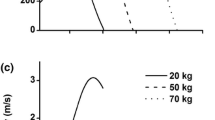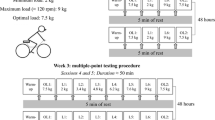Abstract
It is generally accepted that muscles may have different mechanical capacities, such as those for producing high force (F), velocity (V), and power (P) outputs. Nevertheless, standard procedures for evaluation of muscle function both in research and in routine testing are typically conducted under a single mechanical condition, such as a single external load. Therefore, the observed outcomes do not allow for distinguishing between the different muscle capacities. As a result, the outcomes of most routine testing procedures are of limited informational value, whereas a number of issues debated in research have originated from arbitrarily interpreted experimental findings regarding specific muscle capacities. A solution for this problem could be based on the approximately linear and exceptionally strong F–V relationship typically observed from various functional tasks performed under different external loads. These findings allow for the ‘two-load method’ proposed here: the functional movement tasks (e.g., maximum jumping, cycling, running, pushing, lifting, or throwing) should be tested against just two distinctive external loads. That is, the F–V relationship determined by two pairs of the F and V data could provide the parameters depicting the maximum F (i.e., the F-intercept), V (V-intercept), and P (calculated from the product of F and V) output of the tested muscles. Therefore, the proposed two-load method applied in both research and routine testing could provide a deeper insight into the mechanical properties and function of the tested muscles and resolve a number of issues debated in the literature.

Similar content being viewed by others
References
Fleishman EA. The structure and measurement of physical fitness. Englewood Cliffs: Prentice-Hall; 1964.
Hill AV. The heat of shortening and the dynamic constants of muscle. Proc Roy Soc (Lond). 1938;126(843):136–95.
Jaric S. Force–velocity relationship of muscles performing multi-joint maximum performance tasks. Int J Sports Med. 2015;36(9):699–704.
Samozino P, Rejc E, Di Prampero PE, et al. Optimal force–velocity profile in ballistic movements–altius: citius or fortius? Med Sci Sports Exerc. 2012;44(2):313–22.
Kaneko M, Fuchimoto T, Toji H, et al. Training effect of different loads on the force–velocity relationship and mechanical power output in human muscle. Scand J Med Sci Sports. 1983;5(2):50–5.
Cormie P, McGuigan MR, Newton RU. Developing maximal neuromuscular power: part 2—training considerations for improving maximal power production. Sports Med. 2011;41(2):125–46.
McMahon TA. Muscles, reflexes, and locomotion. Princeton: Princeton University Press; 1984.
van Soest AJ, Casius LJ. Which factors determine the optimal pedaling rate in sprint cycling? Med Sci Sports Exerc. 2000;32(11):1927–34.
Kawamori N, Rossi SJ, Justice BD, et al. Peak force and rate of force development during isometric and dynamic mid-thigh clean pulls performed at various intensities. J Strength Cond Res. 2006;20(3):483–91.
Yamauchi J, Ishii N. Relations between force–velocity characteristics of the knee-hip extension movement and vertical jump performance. J Strength Cond Res. 2007;21(3):703–9.
Markovic G, Jaric S. Is vertical jump height a body size-independent measure of muscle power? J Sports Sci. 2007;25(12):1355–63.
Wilkie DR. The relationship between force and velocity in human muscle. J Physiol. 1950;110:249–80.
Nikolaidis PT. Age- and sex-related differences in force–velocity characteristics of upper and lower limbs of competitive adolescent swimmers. J Hum Kinet. 2012;32:87–95.
Driss T, Vandewalle H. The measurement of maximal (anaerobic) power output on a cycle ergometer: a critical review. Biomed Res Int. 2013;13:1–40.
Driss T, Vandewalle H, Le Chevalier JM, et al. Force–velocity relationship on a cycle ergometer and knee-extensor strength indices. Can J Appl Physiol. 2002;27(3):250–62.
Vandewalle H, Peres G, Heller J, et al. Force–velocity relationship and maximal power on a cycle ergometer. Correlation with the height of a vertical jump. Eur J Appl Physiol. 1987;56(6):650–6.
Giroux C, Rabita G, Chollet D, et al. What is the best method for assessing lower limb force–velocity relationship? Int J Sports Med. 2015;36(2):143–9.
Cuk I, Markovic M, Nedeljkovic A, et al. Force–velocity relationship of leg extensors obtained from loaded and unloaded vertical jumps. Eur J Appl Physiol. 2014;114(8):1703–14.
Feeney D, Stanhope SJ, Kaminski TW, et al. Loaded vertical jumping: force–velocity relationship, work, and power. J Appl Biomech. 2016;32(2):120–7.
Morin JB, Samozino P, Bonnefoy R, et al. Direct measurement of power during one single sprint on treadmill. J Biomech. 2010;43(10):1970–5.
Rabita G, Dorel S, Slawinski J, et al. Sprint mechanics in world-class athletes: a new insight into the limits of human locomotion. Scand J Med Sci Sports. 2015;25(5):583–94.
Samozino P, Rejc E, di Prampero PE, et al. Force–velocity properties’ contribution to bilateral deficit during ballistic push-off. Med Sci Sports Exerc. 2014;46(1):107–14.
Yamauchi J, Mishima C, Nakayama S, et al. Force–velocity, force–power relationships of bilateral and unilateral leg multi-joint movements in young and elderly women. J Biomech. 2009;42(13):2151–7.
Meylan CM, Cronin JB, Oliver JL, et al. The reliability of isoinertial force–velocity–power profiling and maximal strength assessment in youth. Sports Biomech. 2015;14(1):68–80.
Sreckovic S, Cuk I, Djuric S, et al. Evaluation of force–velocity and power–velocity relationship of arm muscles. Eur J Appl Physiol. 2015;115(8):1779–87.
García-Ramos A, Jaric S, Padial P, et al. Force–velocity relationship of upper body muscles: traditional versus ballistic bench press. J Appl Biomech. 2016;32(2):178–85.
Ravier G, Grappe F, Rouillon JD. Application of force–velocity cycle ergometer test and vertical jump tests in the functional assessment of karate competitor. J Sports Med Phys Fitness. 2004;44(4):349–55.
Samozino P, Edouard P, Sangnier S, et al. Force–velocity profile: imbalance determination and effect on lower limb ballistic performance. Int J Sports Med. 2014;35(6):505–10.
Jaric S, Markovic G. Body mass maximizes power output in human jumping: a strength-independent optimum loading behavior. Eur J Appl Physiol. 2013;113(12):2913–23.
Bobbert MF. Why is the force–velocity relationship in leg press tasks quasi-linear rather than hyperbolic? J Appl Physiol. 2012;112(12):1975–83.
Bobbert MF. Effect of unloading and loading on power in simulated countermovement and squat jumps. Med Sci Sports Exerc. 2014;46(6):1176–84.
Driss T, Vandewalle H, Monod H. Maximal power and force–velocity relationships during cycling and cranking exercises in volleyball players. Correlation with the vertical jump test. J Sports Med Phys Fitness. 1998;38(4):286–93.
Mandic R, Jakovljevic S, Jaric S. Effects of countermovement depth on kinematic and kinetic patterns of maximum vertical jumps. J Electromyogr Kinesiol. 2015;25(2):265–72.
Leontijevic B, Pazin N, Kukolj M, et al. Selective effects of weight and inertia on maximum lifting. Int J Sports Med. 2013;34(3):232–8.
Author information
Authors and Affiliations
Corresponding author
Ethics declarations
Funding
The study was partly supported by a National Institutes of Health Grant (R21AR06065) and a Grant from the Serbian Research Council (#175037).
Conflict of interest
Slobodan Jaric declares he has no conflicts of interest relevant to the content of this review.
Rights and permissions
About this article
Cite this article
Jaric, S. Two-Load Method for Distinguishing Between Muscle Force, Velocity, and Power-Producing Capacities. Sports Med 46, 1585–1589 (2016). https://doi.org/10.1007/s40279-016-0531-z
Published:
Issue Date:
DOI: https://doi.org/10.1007/s40279-016-0531-z




